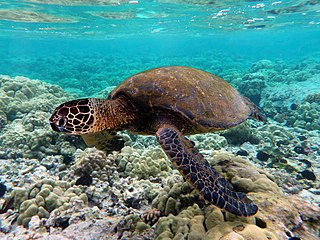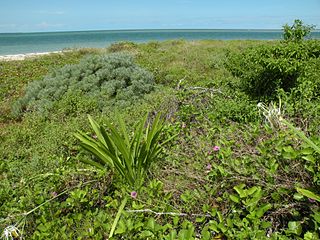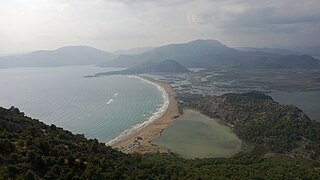
Sanibel is an island and city in Lee County, Florida, United States. The population was 6,382 at the 2020 census, down from 6,469 at the 2010 census. It is part of the Cape Coral-Fort Myers, Florida Metropolitan Statistical Area. The island, also known as Sanibel Island, constitutes the entire city. It is a barrier island—a collection of sand on the leeward side of the more solid coral-rock of Pine Island.

Sea turtles, sometimes called marine turtles, are reptiles of the order Testudines and of the suborder Cryptodira. The seven existing species of sea turtles are the flatback, green, hawksbill, leatherback, loggerhead, Kemp's ridley, and olive ridley. Six of the seven sea turtle species, all but the flatback, are present in U.S. waters, and are listed as endangered and/or threatened under the Endangered Species Act. All but the flatback turtle are listed as threatened with extinction globally on the IUCN Red List of Threatened Species. The flatback turtle is found only in the waters of Australia, Papua New Guinea, and Indonesia.

Cheloniidae is a family of typically large marine turtles that are characterised by their common traits such as, having a flat streamlined wide and rounded shell and almost paddle-like flippers for their forelimbs. They are the only sea turtles to have stronger front limbs than back limbs. The six species that make up this family are: the green sea turtle, loggerhead sea turtle, olive ridley sea turtle, hawksbill sea turtle, flatback sea turtle and the Kemp's ridley sea turtle.

The leatherback sea turtle, sometimes called the lute turtle, leathery turtle or simply the luth, is the largest of all living turtles and the heaviest non-crocodilian reptile, reaching lengths of up to 2.7 metres and weights of 500 kilograms (1,100 lb). It is the only living species in the genus Dermochelys and family Dermochelyidae. It can easily be differentiated from other modern sea turtles by its lack of a bony shell; instead, its carapace is covered by oily flesh and flexible, leather-like skin, for which it is named. Leatherback turtles have a global range, although there are multiple distinct subpopulations. The species as a whole is considered vulnerable, and some of its subpopulations are critically endangered.

The loggerhead sea turtle is a species of oceanic turtle distributed throughout the world. It is a marine reptile, belonging to the family Cheloniidae. The average loggerhead measures around 90 cm (35 in) in carapace length when fully grown. The adult loggerhead sea turtle weighs approximately 135 kg (298 lb), with the largest specimens weighing in at more than 450 kg (1,000 lb). The skin ranges from yellow to brown in color, and the shell is typically reddish brown. No external differences in sex are seen until the turtle becomes an adult, the most obvious difference being the adult males have thicker tails and shorter plastrons than the females.

Cayo Costa State Park is a state park in the U.S. state of Florida, on Cayo Costa, an island directly south of Boca Grande and just north of North Captiva Island, approximately 12 miles (19 km) west of Cape Coral. The park is accessible only by charter boat, private boat, ferry or helicopter.

The Key West National Wildlife Refuge is a 189,497 acre (766.867 km2) National Wildlife Refuge located in Monroe County, Florida, between Key West, Florida and the Dry Tortugas. Only 2,019 acres (8.171 km2) of land are above sea level, on several keys within the refuge. These keys are unpopulated and are also designated as Wilderness within the Florida Keys Wilderness. The refuge was established to provide a preserve and breeding ground for native birds and other wildlife as well as to provide habitat and protection for endangered and threatened fish, wildlife, plants and migratory birds.

The Archie Carr National Wildlife Refuge is part of the United States National Wildlife Refuge (NWR) System, located along a twenty-mile (30 km) section of coastline from Melbourne Beach to Wabasso Beach, Florida, along State Road A1A. The 900 acre (3.6 km2) refuge was established in 1991, to protect the loggerhead and green sea turtles.

Wassaw Island is one of the Sea Islands. It is located on the Atlantic Ocean off the coast of the U.S. state of Georgia and is within the borders of Chatham County. The island and its surrounding marshlands are part of the Wassaw National Wildlife Refuge, which has a total area of 10,053 acres (40.68 km2) of marsh, mudflats, and tidal creeks, including approximately 7 miles (11 km) of undeveloped beaches. The land mass is 76 percent salt marshes and 24 percent beaches, dunes, and maritime forest. The refuge is a part of the Savannah Coastal Refuges Complex.

İztuzu Beach is a 4.5 km long beach near Dalyan, in the Ortaca district of the Province of Muğla in southwestern Turkey. The beach is a narrow spit of land, which forms a natural barrier between the fresh water delta of the Dalyan river and the Mediterranean. It is one of the main breeding grounds for loggerhead sea turtles in the Mediterranean and is therefore often referred to as Turtle Beach. The loggerhead turtle is on the IUCN Red list of endangered animals. For this reason the beach has had a protected status since 1988 and is part of the Köyceğiz-Dalyan Special Environmental Protection Area.

The Cape Romain National Wildlife Refuge is a 66,287 acre (267 km²) National Wildlife Refuge in southeastern South Carolina near Awendaw, South Carolina. The refuge lands and waters encompass water impoundments, creeks and bays, emergent salt marsh and barrier islands. 29,000 acres (120 km2) are designated as Class I Wilderness. Most of the refuge is only accessible by boat. The Intracoastal Waterway passes the Refuge. Mainland facilities include the refuge's headquarters and visitor center which are located on U.S. Highway 17 about 30 minutes by car from Charleston, South Carolina.

The Bahia mangroves is a tropical ecoregion of the mangroves biome, and the South American Atlantic Forest biome, located in Northeastern Brazil. Its conservation status is considered to be critical/endangered due to global climate change and other factors.

The River, Estuary, and Coastal Observing Network (RECON) is a pioneering waterway observing system founded and maintained by Sanibel-Captiva Conservation Foundation (SCCF) operated by the SCCF's Marine Laboratory at Tarpon Bay.

The National Marine Park of Zakynthos founded in 1999, is a national park located in Laganas bay, in Zakynthos island, Greece. The park, part of the Natura 2000 ecological network, covers an area of 135 square kilometres (52 sq mi) and is the habitat of the loggerhead sea turtle. It is the first national park established for the protection of sea turtles in the Mediterranean.

The Canadian Organization for Tropical Education and Rainforest Conservation (COTERC) is a registered not-for-profit Canadian-based charity. COTERC was founded in 1991 by Marilyn Cole and Ozzie Teichner, and is based in Pickering, Ontario, Canada. COTERC maintains a close reciprocal relationship in Costa Rica with Caño Palma Biological Station.

Washington Slagbaai National Park is a national park and ecological reserve on the northwestern part of the island of Bonaire in the Caribbean Netherlands. The 5,643 hectares (21.79 sq mi) park covering approximately a fifth of the island of Bonaire is managed by STINAPA Bonaire, a non-profit foundation, on behalf of the Bonaire government. Established in 1969, Washington Slagbaai National Park was the first nature reserve to be established in the former Netherlands Antilles.
The Leatherback Trust is a non-profit organization dedicated to the conservation and study of sea turtles and freshwater turtles, with special regard for the leatherback sea turtle. The Leatherback Trust was founded in 2000 to help consolidate Las Baulas National Marine Park, one of the last major nesting site for the critically endangered leatherback turtle in the Eastern Pacific Ocean. The park protects Playa Grande, Playa Ventanas, Playa Langosta, the ocean out to 12 nautical miles, wetlands, highlands, and the coast inland to 125 m from the high tide line.

The Gnaraloo Turtle Conservation Program (GTCP) is an environmental organisation based at the Gnaraloo pastoral station and run by the Gnaraloo Wilderness Foundation, a not-for-profit organisation. The aim of the GTCP is to identify, monitor and protect the nesting beaches of loggerhead sea turtles found at two locations on the Gnaraloo coastline. These two rookeries contribute to the South-East Indian Ocean subpopulation of loggerhead turtles, with other major nesting sites for this sub-population at Dirk Hartog island and Exmouth. This is within the southern boundaries of the Ningaloo Coast marine area, a UNESCO World Heritage Site.
The Bald Head Island Conservancy (BHIC) is a non-profit organization founded November 7, 1983. BHIC's mission is barrier island conservation, preservation and education. It is located in the Smith Island Complex in Brunswick County, North Carolina, which includes Bald Head Island, Middle and Bluff Islands, all of which are bounded by the Cape Fear River and the Atlantic Ocean. BHIC sponsors and facilitates scientific research that benefits coastal communities and provides numerous recreational and educational activities for students, educators, visitors, and residents. In coordination with various organizations, partnerships and collaborations, the Conservancy has led the nation in conservation and research efforts and is uniquely poised to become a leader in Barrier Island Conservation world-wide.

The Gnaraloo Feral Animal Control Program (GFACP) operates in conjunction with the Gnaraloo Turtle Conservation Program (GTCP), a non-governmental organization whose aim is to monitor and protect sea turtle nesting beaches along the coast of Gnaraloo. Since its implementation in 2009, the GFACP has worked to reduce the impact of feral predators on sea turtle nests within these rookeries. Gnaraloo is located at the southern end of the Ningaloo Coast, a World Heritage Site. The Ningaloo Reef and surrounding coastline are home to important wildlife, including vulnerable and endangered sea turtle populations.


















